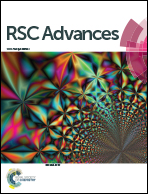A water-soluble fluorescent hybrid material based on aminoclay and its bioimaging application†
Abstract
A water-soluble fluorescent hybrid material has been prepared by functionalization of aminoclay with a fluorescent dye (NDPA). UV-vis absorbance, FT-IR/fluorescent spectroscopy, SEM and TEM techniques were used to investigate its structural, fluorescence and morphological features. The results indicated that the organic fluorescent group can be covalently anchored onto aminoclay through the reaction of the amino-group, and the obtained AC–NDPA exhibited good water solubility and fluorescence properties, coupled with high dispersibility in aqueous solution. Further study found that AC–NDPA had low biotoxicity, and live cell imaging showed that AC–NDPA can be efficiently phagocytized by HeLa cells, bright blue emission can be observed in the cytoplasm and nucleus of HeLa cells by con-focal laser scanning microscopy. We expect that this work could reveal the potential for using the aminoclay based fluorescent material as an effective staining reagent for in vivo bioimaging.



 Please wait while we load your content...
Please wait while we load your content...